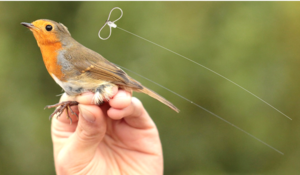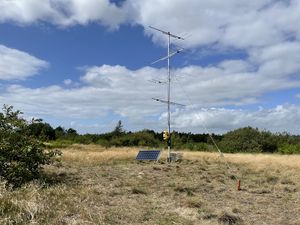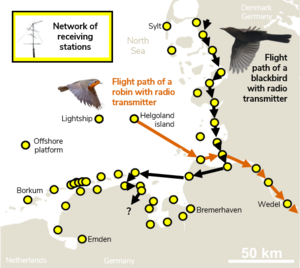Mitchell, L., Brust, V., Karwinkel, T., Åkesson, S., Kishkinev, D., Norevik, G., Szep, T., Hedenström, A., Lagerveld, S., Helm, B., & Schmaljohann, H. (2025). Conservation-focused mapping of avian migratory routes using a pan-European automated telemetry network. Conservation Biology, e70017. https://doi.org/10.1111/cobi.70017
Lagerveld, S., de Vries, P., Harris, J., Parsons, S., Debusschere, E., Hüppop, O., ... & Schmaljohann, H. (2024). Migratory movements of bats are shaped by barrier effects, sex-biased timing and the adaptive use of winds. Movement Ecology, 12(1), 81. https://doi.org/10.1186/s40462-024-00520-7
Mitchell, L., Brust, V., Karwinkel, T., Åkesson, S., Kishkinev, D., Norevik, G., ... & Schmaljohann, H. (2024). Mapping migratory routes: Avian conservation-focused opportunities for a pan-European automated telemetry network. https://doi.org/10.32942/X2TG99
Karwinkel, T., Winklhofer, M., Allenstein, D., Brust, V., Christoph, P., Holland, R. A., ... & Schmaljohann, H. (2024). A refined magnetic pulse treatment method for magnetic navigation experiments with adequate sham control: a case study on free-flying songbirds. Journal of the Royal Society Interface, 21(214), 20230745.
Rüppel, G., Hüppop, O., Schmaljohann, H., & Brust, V. (2023). The urge to breed early: Similar responses to environmental conditions in short‐and long‐distance migrants during spring migration. Ecology and Evolution, 13(7), e10223.
Rüppel, G., Hüppop, O., Lagerveld, S., Schmaljohann, H., & Brust, V. (2023). Departure, routing and landing decisions of long-distance migratory songbirds in relation to weather. Royal Society Open Science, 10(2), 221420.
Eikenaar, C., Ostolani, A., Brust, V., Karwinkel, T., Schmaljohann, H., & Isaksson, C. (2023). The oxidative balance and stopover departure decisions in a medium-and a long-distance migrant. Movement Ecology, 11(1), 7.
Brust, V., Schmaljohann, H., & Hüppop, O. (2023). Two subspecies of a songbird migrant optimise departure from a coastal stopover with regard to weather and the route lying ahead. Journal of Avian Biology, 2023(1-2), e03004.
Brust, V., Eikenaar, C., Packmor, F., Schmaljohann, H., Hüppop, O., & Czirják, G. Á. (2022). Do departure and flight route decisions correlate with immune parameters in migratory songbirds?. Functional ecology, 36(12), 3007-3021.
Bach, P., Voigt, C. C., Göttsche, M., Bach, L., Brust, V., Hill, R., ... & Seebens‐Hoyer, A. (2022). Offshore and coastline migration of radio‐tagged Nathusius' pipistrelles. Conservation Science and Practice, 4(10), e12783.
Karwinkel, T., Winklhofer, M., Janner, L. E., Brust, V., Hüppop, O., Bairlein, F., & Schmaljohann, H. (2022). A magnetic pulse does not affect free-flight navigation behaviour of a medium-distance songbird migrant in spring. Journal of Experimental Biology, 225(19), jeb244473.
Karwinkel, T., Winklhofer, M., Christoph, P., Allenstein, D., Hüppop, O., Brust, V., ... & Schmaljohann, H. (2022). No apparent effect of a magnetic pulse on free-flight behaviour in northern wheatears (Oenanthe oenanthe) at a stopover site. Journal of the Royal Society Interface, 19(187), 20210805.
Brust V, Hüppop O (2021) Underestimated scale of songbird offshore migration across the south-eastern North Sea during autumn. Journal of Ornithology, 1-10.
Michalik B, Brust V, Hüppop O (2020) Are movements of daytime and nighttime passerine migrants as different as day and night? Ecology and Evolution 00: 1-12,
Schmaljohann, H., & Klinner, T. (2020). A quasi-experimental approach using telemetry to assess migration-strategy-specific differences in the decision-making processes at stopover. BMC ecology, 20, 1-12.
Packmor, F., Klinner, T., Woodworth, B. K., Eikenaar, C., & Schmaljohann, H. (2020). Stopover departure decisions in songbirds: do long-distance migrants depart earlier and more independently of weather conditions than medium-distance migrants?. Movement Ecology, 8, 1-14.
Eikenaar, C., Schaefer, J., Hessler, S., Packmor, F., & Schmaljohann, H. (2020). Diel variation in corticosterone and departure decision making in migrating birds. Hormones and behavior, 122, 104746.
Brust V, Michalik B, Hüppop O (2019) To cross or not to cross – thrushes at the German North Sea coast adapt flight and routing to wind conditions in autumn, Movement Ecology 7:32,
Eikenaar, C., Packmor, F., Schmaljohann, H., & Hegemann, A. (2019). Stopover departure decisions in autumn are not associated with constitutive immune function in Northern Wheatears Oenanthe oenanthe. Journal of ornithology, 160, 813-817.
Eikenaar, C., Hessler, S., Ballstaedt, E., Schmaljohann, H., & Kaiya, H. (2018). Ghrelin, corticosterone and the resumption of migration from stopover, an automated telemetry study. Physiology & behavior, 194, 450-455.
Schmaljohann, H., Mueller, F., Klinner, T., & Eikenaar, C. (2018). Potential age differences in the migratory behaviour of a nocturnal songbird migrant during autumn and spring. Journal of Avian Biology, 49(7), e01815.
Müller, F., Eikenaar, C., Crysler, Z. J., Taylor, P. D., & Schmaljohann, H. (2018). Nocturnal departure timing in songbirds facing distinct migratory challenges. Journal of Animal Ecology, 87(4), 1102-1115.
Eikenaar, C., Müller, F., Leutgeb, C., Hessler, S., Lebus, K., Taylor, P. D., & Schmaljohann, H. (2017). Corticosterone and timing of migratory departure in a songbird. Proceedings of the Royal Society B: Biological Sciences, 284(1846), 20162300.





